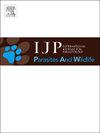COI barcoding can distinguish bisexual and parthenogenetic populations of Haemaphysalis longicornis in Japan: Revisiting methods with SNP analysis as another possible method
IF 2.2
3区 医学
Q3 ECOLOGY
International Journal for Parasitology-Parasites and Wildlife
Pub Date : 2025-05-15
DOI:10.1016/j.ijppaw.2025.101083
引用次数: 0
Abstract
Haemaphysalis longicornis, the Asian long-horned tick, is an important vector for various infectious diseases, such as severe fever with thrombocytopenia syndrome (SFTS) and Japanese spotted fever. In this species, a triploid parthenogenetic reproductive form occurs along with a diploid bisexual form. Several approaches have been used to distinguish these two groups, including the presence/absence of males in the population, karyotyping, flow cytometry, and most recently, mitochondrial phylogeny. Mitochondrial gene (COI) barcoding has also been casually used, although its validity has not been investigated. In the present study, the validity of COI barcoding, genotyping nuclear markers (SNPs), and morphometrics was evaluated for distinguishing the reproductive forms of H. longicornis in Japan. Ticks were collected using the flagging method at two locations in Hyogo, Japan. DNA was extracted from ticks after photography, which was used for morphometric measurements. The DNA was used for COI barcoding by direct sequencing and genotyping SNPs in the nuclear genome. The resulting COI haplotypes were clustered into two distinct haplogroups, which represented different ploidy levels, corresponding to the different reproductive groups. Genotypes of nuclear SNPs supported that the individuals from each mitochondrial haplogroup belonged to distinct reproductive populations with different ploidy levels. Meanwhile, although significant differences were observed in multiple morphometric characteristics between these reproductive groups, large overlaps were generally evident in the distribution, indicating that morphological identification is not sufficient to distinguish the reproductive groups. This study suggested for the first time that COI barcoding and SNP genotyping are both convenient and reliable methods to distinguish the two reproductive forms of H. longicornis in Japan.

COI条形码可以区分日本长角血蜱的双性和孤雌生殖群体:以SNP分析作为另一种可能的方法
亚洲长角血蜱是多种传染病的重要媒介,如发热伴血小板减少综合征(SFTS)和日本斑疹热。在这个物种中,三倍体孤雌生殖形式与二倍体双性生殖形式一起发生。已经使用了几种方法来区分这两个群体,包括群体中男性的存在/缺失,核型,流式细胞术,以及最近的线粒体系统发育。线粒体基因(COI)条形码也被随意使用,尽管其有效性尚未得到调查。本研究对COI条形码、基因分型核标记(SNPs)和形态计量学在日本长角蜱生殖形式区分中的有效性进行了评价。在日本兵库县的两个地点采用标记法采集蜱虫。摄影后从蜱虫中提取DNA,用于形态测量。通过直接测序和核基因组snp分型,将DNA用于COI条形码。COI单倍型聚为两个不同的单倍群,代表不同的倍性水平,对应于不同的生殖群体。核单核苷酸多态性的基因型支持每个线粒体单倍群的个体属于不同的生殖群体,具有不同的倍性水平。同时,尽管这些生殖类群在多个形态特征上存在显著差异,但在分布上普遍存在较大的重叠,表明形态识别不足以区分生殖类群。本研究首次表明,COI条形码和SNP基因分型是区分日本长角蜱两种生殖形式的方便、可靠的方法。
本文章由计算机程序翻译,如有差异,请以英文原文为准。
求助全文
约1分钟内获得全文
求助全文
来源期刊

International Journal for Parasitology-Parasites and Wildlife
Medicine-Infectious Diseases
CiteScore
3.80
自引率
5.60%
发文量
113
审稿时长
45 days
期刊介绍:
The International Journal for Parasitology: Parasites and Wildlife (IJP-PAW) publishes the results of original research on parasites of all wildlife, invertebrate and vertebrate. This includes free-ranging, wild populations, as well as captive wildlife, semi-domesticated species (e.g. reindeer) and farmed populations of recently domesticated or wild-captured species (e.g. cultured fishes). Articles on all aspects of wildlife parasitology are welcomed including taxonomy, biodiversity and distribution, ecology and epidemiology, population biology and host-parasite relationships. The impact of parasites on the health and conservation of wildlife is seen as an important area covered by the journal especially the potential role of environmental factors, for example climate. Also important to the journal is ''one health'' and the nature of interactions between wildlife, people and domestic animals, including disease emergence and zoonoses.
 求助内容:
求助内容: 应助结果提醒方式:
应助结果提醒方式:


